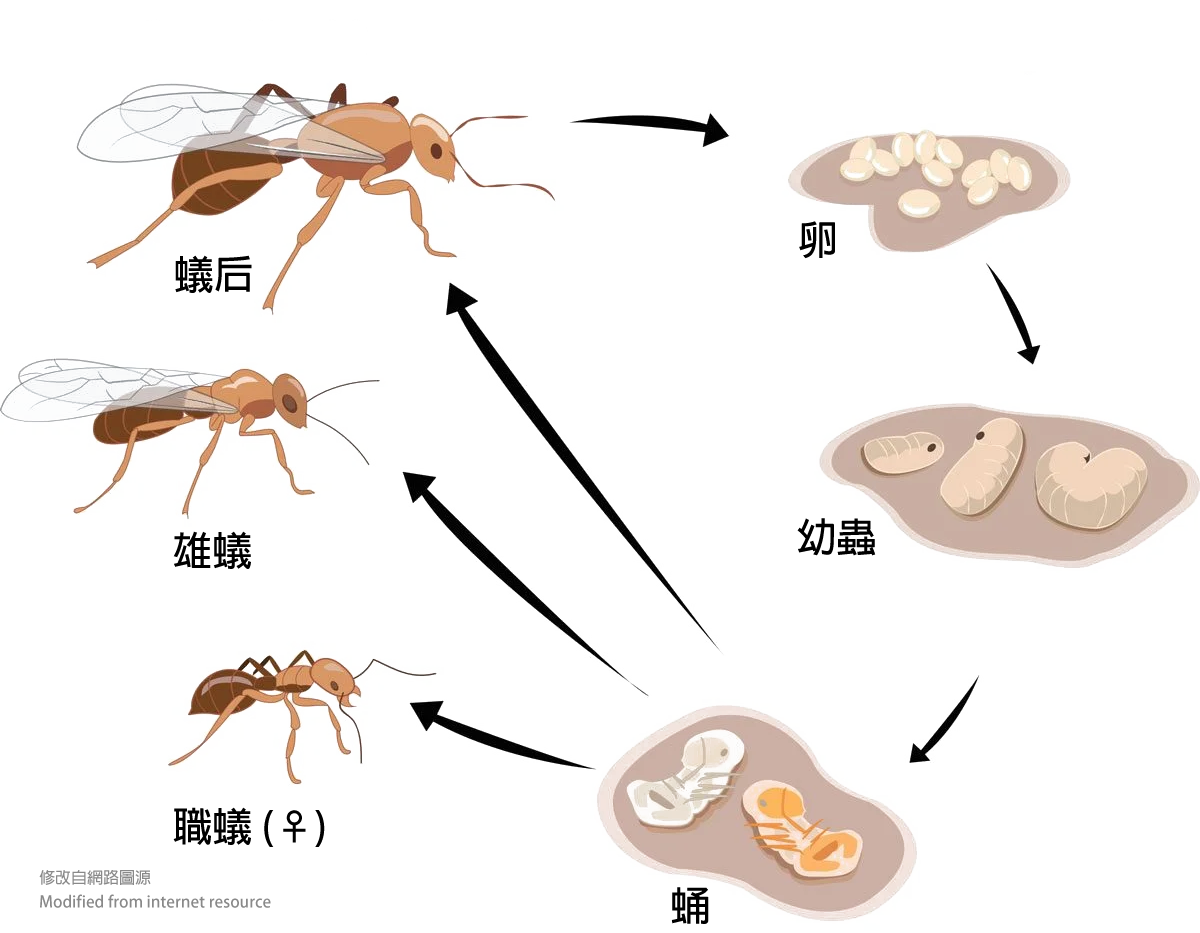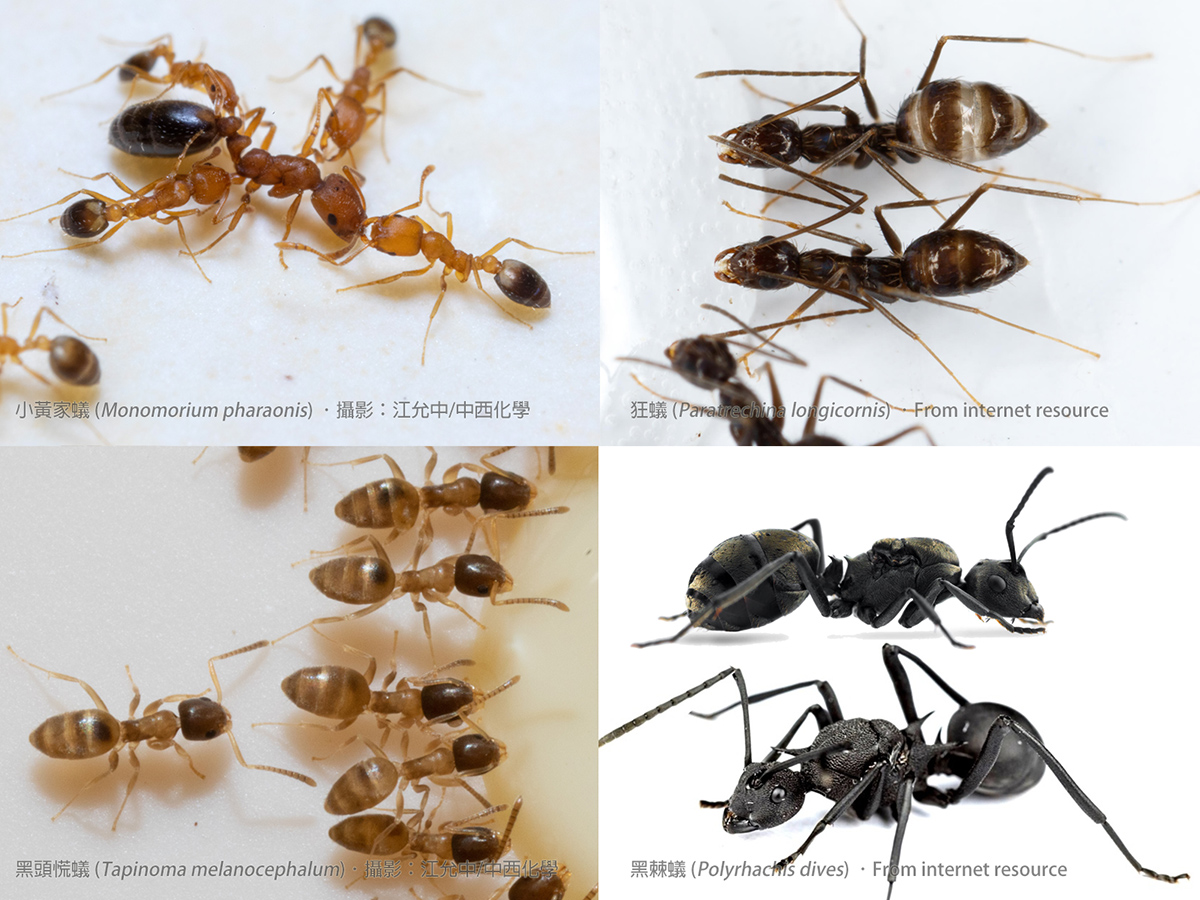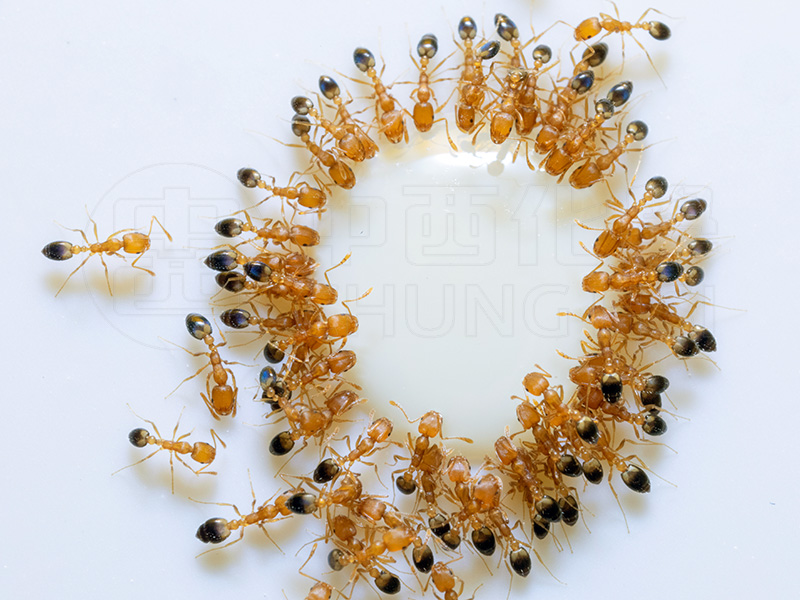BACK
2023 / 12 / 25

Ants are insects of the family Formicidae in the order Hymenoptera, and their closest relatives are wasps. According to scholars' research, there are about 300 species of ants in Taiwan. Most of them live in mountains and forests and have almost no direct relationship with us. There are not many ants that can be called harmful species, but they are often very threatening.
Except the red imported fire ant, common ants that are considered harmful or nuisance include: ghost ant (Tapinoma melanocephalum), pharaoh ant (Monomorium pharaonis), flower ant (M. floricola), big-headed ant (Pheidole megacephala), Asian marauder ant (Carebara diversa, synonym: Pheidologeton diversus), longhorn (or black) crazy ant (Paratrechina longicornis), rich spiny sugar ant (Polyrhachis dives), yellow crazy ant (Anoplolepis gracilipes), an recently raised ant species from subfamily Dolichoderinae: black cocoa ant (Dolichoderus thoracicus) and Technomyrmex brunneus, etc.
Except the red imported fire ant, common ants that are considered harmful or nuisance include: ghost ant (Tapinoma melanocephalum), pharaoh ant (Monomorium pharaonis), flower ant (M. floricola), big-headed ant (Pheidole megacephala), Asian marauder ant (Carebara diversa, synonym: Pheidologeton diversus), longhorn (or black) crazy ant (Paratrechina longicornis), rich spiny sugar ant (Polyrhachis dives), yellow crazy ant (Anoplolepis gracilipes), an recently raised ant species from subfamily Dolichoderinae: black cocoa ant (Dolichoderus thoracicus) and Technomyrmex brunneus, etc.
If you observe their living habits, you will find that the ghost ants and the pharaoh ants are the species that can completely settle in an indoor environment. They do not need a real ant nest. Any undisturbed narrow crevice or container can be used as a nest, and then the workers go out to seek for food and water. Other ants mainly live in outdoor environments near houses, using tree holes, bamboo tubes, potted plants, under stones, etc. as their nests. They often invade into the houses for food and water resources.

The problem of these ants bring to us is mainly harassment. They are rarely aggressive towards humans. At most, they bite people defensively or spray formic acid. Their bites are not too painful, which is quite different from the fire ants, whose stings are quite painful and may even cause allergy or even shock. However, what cannot be ignored is that ants crawl around everywhere, so they may contaminate food or objects by mechanically carrying pathogens. For example, if the pharaoh ants invade hospitals or care centers and contaminate medical equipment, it will cause serious consequences. In addition, for many people, ants may cause negative psychological effects such as trypophobia. For example, black cocoa ants and Technomyrmex brunneus have a very large number of individuals, which seriously affects the daily lives of people in the affected areas.
How to control ants in your house
Baits are the most effective products for controlling ants. Because ants are social insects, they rely on some workers to go out to forage for food, come back to share food with other adults, and raise larvae and the queen that keep laying eggs. Therefore, low-toxic baits can be carried back to the nest by workers and passed on to other members via trophallaxis, causing slowly poisoning and the gradual extinction of the colony.
In addition to the active ingredients, the bait also contains food attractants that can lure workers. However, different species of ants have different food preferences. Some like sugar, some like lipid, and some prefer protein-rich foods. The form of food, such as liquid or solid, will affect the workers’willingness to obtain the food and take it away. Even seasonal changes and the growth and decline of their population may cause the ant colony to change its food preferences. These factors become the biggest problem in ant control, because as long as the ants have no interest in the food attractant components in the bait, the control will be a direct failure. It is recommended to observe the feeding preferences of the target ants before purchasing baits. For example, you can make a small amount of homemade sugar water and place it near the ants' movement path for a period of time and observe. If they are interested in the sugar water, then you can consider using sugary liquid baits for further prevention and control. Most of those nuisance ants prefer sugar.
Baits are the most effective products for controlling ants. Because ants are social insects, they rely on some workers to go out to forage for food, come back to share food with other adults, and raise larvae and the queen that keep laying eggs. Therefore, low-toxic baits can be carried back to the nest by workers and passed on to other members via trophallaxis, causing slowly poisoning and the gradual extinction of the colony.
In addition to the active ingredients, the bait also contains food attractants that can lure workers. However, different species of ants have different food preferences. Some like sugar, some like lipid, and some prefer protein-rich foods. The form of food, such as liquid or solid, will affect the workers’willingness to obtain the food and take it away. Even seasonal changes and the growth and decline of their population may cause the ant colony to change its food preferences. These factors become the biggest problem in ant control, because as long as the ants have no interest in the food attractant components in the bait, the control will be a direct failure. It is recommended to observe the feeding preferences of the target ants before purchasing baits. For example, you can make a small amount of homemade sugar water and place it near the ants' movement path for a period of time and observe. If they are interested in the sugar water, then you can consider using sugary liquid baits for further prevention and control. Most of those nuisance ants prefer sugar.


The bait will take some time to work, so be patient when using it. In addition, cleaning the household environment frequently and storing food in sealed containers can effectively reduce ant activity. If you find that ants are invading from outdoors, you can use aerosol or other insecticides to do the residual spray, to make a barrier at key points along the ant invasion path, such as door cracks and window sills, to prevent ants from getting close, which can effectively reduce the invasion rate. But remember that insecticides will gradually decompose, so you can re-apply the insecticide barrier every 3-7 days to maintain the deterrent effect.

